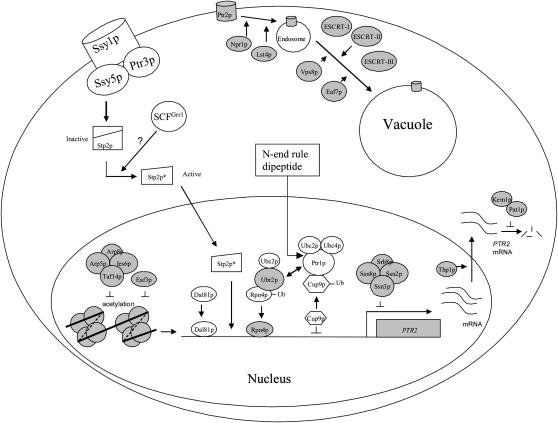Figure 6.
A hypothetical model for the regulation of dipeptide utilization in S. cerevisiae. The proteins with clear background represent those that have been reported previously to be involved in PTR2 regulation. The shaded background represents those proteins that have been determined in this study. The SPS protein complex (Ssy1p-Ptr3p-Ssy5p) is an amino acid sensor, which leads to a cleavage of the N-terminal of Stp2p. The activated form of Stp2p is localized to the nucleus and regulates PTR2 expression. In addition, Dal81p synergistically regulates PTR2 expression together with Stp2p. Other proteins, Rpn4p, a positive regulator, and Cup9p, a negative regulator, bind at the PTR2 promoter region and are also involved in PTR2 transcription. The stability of Rpn4p is modulated by Ubr2p and Ubc2p and the stability of Cup9p by Ptr1p, Ubc2p, and Ubc4p via the ubiquitination pathway. Binding of N-end rule dipeptides to Ptr1p/Ubr1p results in ubiquitin-mediated degradation of Cup9p. Ubr2p competes with Ptr1p for the degradation of Cup9p. Arp5p, Arp8p, Ies6p, and Taf14p (components of the INO80 complex) together with Eaf3p possibly negatively regulate PTR2 transcription via repressing the acetylation of histones in the PTR2 coding region. The transcription of PTR2 is negatively regulated by a RNA polymerase mediator protein complex, which includes Ssn2p, Ssn3p, Ssn8p, and Srb8p. Thp1p might be involved in the translocation of PTR2 mRNA from the nucleus to the cytosol. The interaction between Kem1p and Pat1p is potentially involved in the degradation of PTR2 mRNA. Dipeptide utilization is also modulated by the Ptr2p trafficking system; Srn2p, Vps36p, and Snf7p represent components of ESCRT-I, -II, and -III, together with Vps8p and Eaf7p, which appear to regulate Ptr2p internalization from the endosome to the vacuole. In addition, Npr1 and Lst4p are also involved in Ptr2p trafficking and affect the retention of Ptr2p in the plasma membrane.

